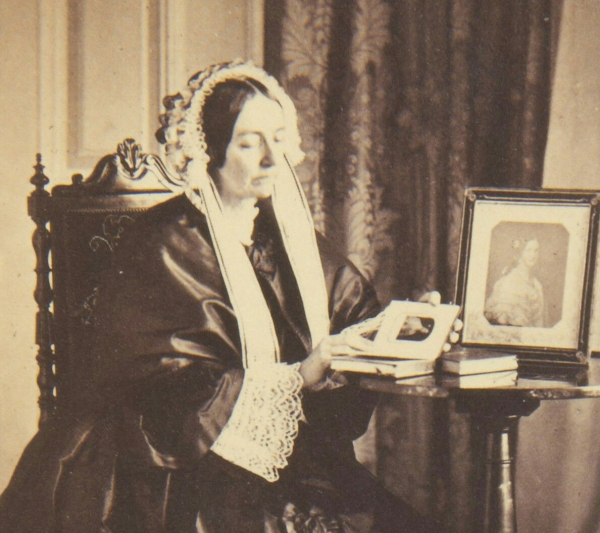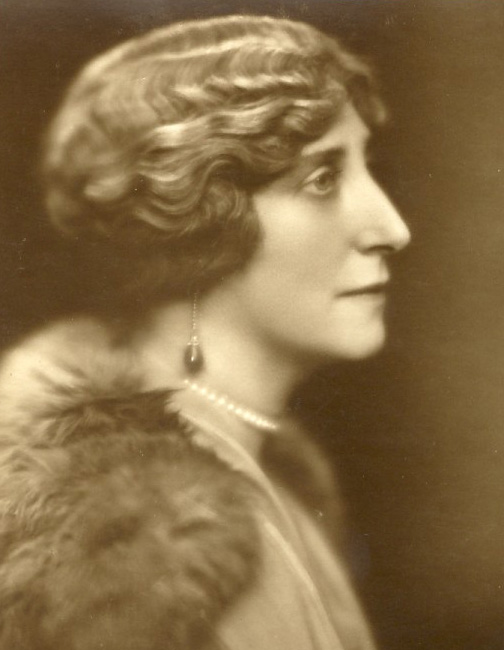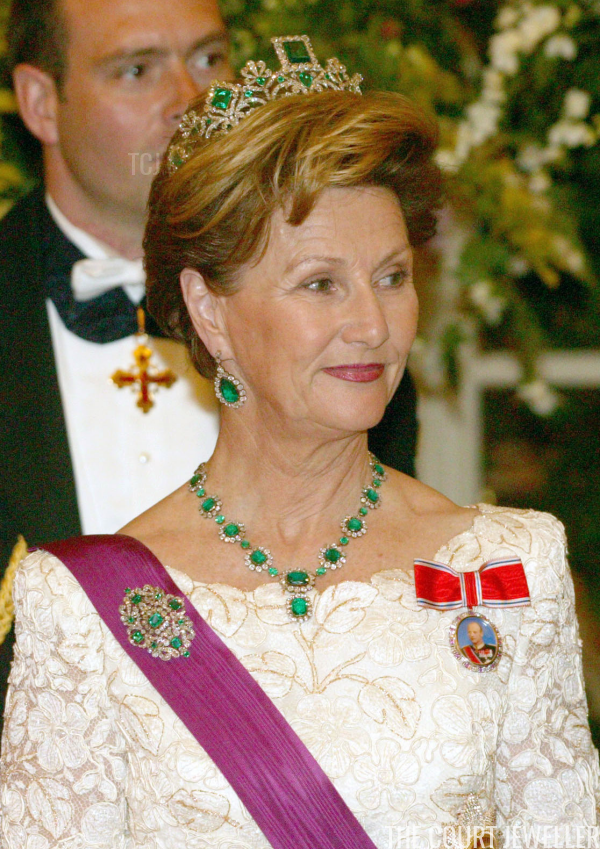 |
| MIGUEL MEDINA/AFP/Getty Images |
The Daily Diadem: The Chaumet Pearl Sunburst Tiara
 |
| United Archives/Alamy |
The Norwegian Emerald Parure
 |
| ODD ANDERSEN/AFP via Getty Images |
One of the most delightful things about royal jewelry is the extensive history witnessed by the glittering gems. Today, we’re discussing a parure that has seen a whole lot over the past two centuries: the grand emerald set now owned by the Norwegian royal family.
 |
| Pascal Le Segretain/Getty Images |
There’s no single accepted theory about the provenance of these fantastic royal emeralds, partly because the creation date of the tiara and the other pieces of the coordinating parure has never been firmly established. The jewels significant stylistic similarities to two diamond and emerald sets created in France at the beginning of the nineteenth century: the emerald and diamond tiara made in 1810 for Napoleon’s second wife, Empress Marie-Louise, by Nitot (and now set with turquoises, not emeralds), and the diamond and emerald tiara made around 1820 by Bapst for the Duchess of Angoulême. Given the similarities to each of these pieces, it’s possible the Norwegian parure was made during the same time frame. But, to complicate things even further, there’s a family story that contradicts a construction date of 1810-20. Historian Trond Norén Isaksen notes that family tradition says that the emeralds in this tiara were mined in Russia; emeralds weren’t discovered in Russia until 1830, so if that’s correct, it was actually made in the 1830s, a least a full decade later than the previous examples.
 |
| Princess Augusta, Duchess of Leuchtenberg (Wikimedia Commons) |
There’s also no clear agreement about the set’s original owner. Some have posited that the parure was originally made for Empress Joséphine, Napoleon’s first wife, who died in 1814. If the jewels were made around 1810, that’s certainly possible. But if the post-1830 creation date is correct, the first owner is more likely to have been Joséphine’s daughter-in-law, the Duchess of Leuchtenberg, who was born Princess Augusta of Bavaria. We know for sure that Augusta acquired the tiara at some point — we just don’t know how or from whom.
 |
| Amelie, Dowager Empress of Brazil, ca. 1860s (Wikimedia Commons) |
In 1851, Augusta died in Munich. Her jewels were divided among her three surviving daughters: Amélie (the Empress of Brazil), Joséphine (the Queen of Sweden and Norway), and Théodolinde (the Duchess of Urach). Amélie, the widow of Emperor Pedro I of Brazil, lived in Lisbon, and the parure found a new home with her at the Palácio de Alvor-Pombal, which today is home to Portugal’s National Museum of Ancient Art.
 |
| Queen Sofia of Sweden wears the emerald tiara in a court portrait |
Amélie kept the emerald parure in her personal collection until she died in Lisbon at the age of sixty. Her only child, Princess Maria Amélia, had died two decades before, and at that point, Amélie had only one living sister: Queen Joséphine, the widow of King Oscar I of Sweden and Norway. Joséphine was already sixty-five, but she became her sister’s sole heir, inheriting her jewelry, including the emerald parure (as well as the grand Braganza parure). She didn’t have long to enjoy the jewels, however: three years after inheriting the emeralds from her sister, Queen Joséphine died in Stockholm at the age of sixty-nine. She left the emeralds to her thirty-nine-year-old daughter-in-law, Queen Sofia, the wife of King Oscar II of Sweden and Norway. The tiara doesn’t seem to have been one of Sofia’s favorites — that title probably belongs to her diamond tiara — but she did wear it for a court portrait.
 |
| Crown Princess Margareta of Sweden (pictured with the entire Connaught family) wears the emeralds for the coronation of King George V and Queen Mary of the United Kingdom, 1911 |
Queen Sofia also generously loaned the tiara to other family members. In 1911, when King George V and Queen Mary were crowned in the United Kingdom, Sofia’s grandson and granddaughter-in-law, Crown Prince Gustaf Adolf and Crown Princess Margareta, were among those attending the coronation. Margareta, who was born Princess Margaret of Connaught, was King George’s first cousin; their fathers were both sons of Prince Albert and Queen Victoria. For the coronation, Sofia loaned the emerald parure to Margareta. The crown prince and princess were photographed with the entire Connaught family at the coronation, and the emeralds are on display in the portrait.
 |
| Princess Ingeborg of Sweden (Wikimedia Commons) |
In 1913, Queen Sofia died in the palace in Stockholm. Rather than designating the emeralds for the use of the country’s current queen, Victoria of Baden, Sofia left them to her daughter-in-law, Princess Ingeborg. Ingeborg was the thirty-five-year-old wife of Sofia’s third son, Prince Carl. Sofia and Victoria had a tense relationship, and Ingeborg was much closer to her mother-in-law. Moreover, though she was the wife of a younger son, Princess Ingeborg had served as Sweden’s de facto first lady during the last years of Oscar II’s reign, and it seems likely that she borrowed her mother-in-law’s emeralds on occasion during that period.
 |
| Princess Ingeborg of Sweden (center) wears the emeralds for the wedding of her daughter, Princess Astrid, to the future King Leopold III of Belgium, 1926 (Chronicle/Alamy) |
Princess Ingeborg made good use of the emeralds during her time as their owner. She wore the emerald parure during the wedding of her daughter, Princess Astrid of Sweden, and the Duke of Brabant (later King Leopold III of the Belgians). She also posed for a portrait wearing the emerald set the same year. At some point afterward, she decided to make alterations to the set. She had the large drop-shaped emeralds atop the tiara removed and remade into a pair of earrings; in their place, a jeweler installed additional diamond palmette elements. She also removed most of the pendants from the necklace and distributed them to various family members. Three of these pendants were given to the late Queen Astrid of the Belgians; the emeralds from those pendants are now a part of the emerald peacock tiara owned by the grand ducal family of Luxembourg.
 |
| Crown Princess Martha wears the earrings and necklace from the parure for the christening of her son, Prince Harald, in 1937 (Chronicle/Alamy) |
The new earrings and altered necklace made a prominent appearance on Princess Ingeborg’s daughter, Crown Princess Märtha of Norway, in 1937. She borrowed the necklace and earrings from the parure from her mother for the christening of her son, Prince Harald, that March. (Harald would later become King Harald V of Norway.)
 |
| Crown Prince Olav and Crown Princess Martha of Norway at Westminster Abbey during the 1937 coronation (Photo 12/Alamy) |
A few months later, in May 1937, Ingeborg loaned the emeralds to Crown Princess Märtha again, this time for the coronation of King George VI and Queen Elizabeth of the United Kingdom. She wore the emeralds in Westminster Abbey for the coronation ceremony — the second time the emeralds witnessed a British coronation. Märtha quickly returned the emeralds to her mother; six days after the British coronation, Princess Ingeborg wore the set during the Silver Jubilee celebrations for her cousin, King Christian X of Denmark, in Copenhagen.
 |
| The Norwegian royal family returns to Oslo after the end of World War II (Wikimedia Commons) |
Soon after, World War II broke out in Europe, and the emeralds gained new importance to Ingeborg and her family. In 1940, Crown Princess Märtha and her three children — Princess Ragnhild, Princess Astrid, and Prince Harald — fled Norway for the distant safety of America, stopping briefly at her parents’ home in Sweden on the way. Princess Ingeborg accompanied her daughter and grandchildren to the train station in Stockholm. On the platform, she handed her a package. Inside was the emerald parure. The gems were meant to be an insurance policy: Ingeborg instructed her daughter to sell the valuable heirloom jewels if her family faced a financial crisis in the midst of war. Thankfully, it didn’t come to that. When the war ended in 1945, Märtha and her children returned to Norway. The emerald set came with her, and the parure became one of the grandest and most important jewelry sets in the Norwegian royal vaults.
 |
| Crown Princess Martha and Crown Prince Olav of Norway attend a gala at Olympic Stadium in Amsterdam during the inauguration of Queen Juliana of the Netherlands, 1948 (Anefo/Nationaal Archief/Wikimedia Commons) |
Crown Princess Märtha made several important glittering appearances in the emeralds. In September 1948, she wore the parure for an event at the Olympic Stadium in Amsterdam during the inauguration of Queen Juliana of the Netherlands.
 |
| Crown Princess Martha wears the emeralds at the 1953 coronation of Queen Elizabeth II of the United Kingdom; note the use of another emerald brooch as a pendant on the necklace (Chronicle/Alamy) |
Five years later, she wore the emeralds for yet another British coronation, witnessing the crowning of Queen Elizabeth II of the United Kingdom in Westminster Abbey. The emeralds have the distinction, therefore, of attending all three of the most recent coronations in Britain. A month later, Märtha also wore the emeralds at the celebrations for the fiftieth birthday of her husband, Crown Prince Olav.
 |
| Crown Princess Martha wears the emerald set for a formal portrait (Keystone Press/Alamy) |
Sadly, however, that birthday gala would be one of the last times Crown Princess Märtha wore the emerald set. In 1954, she died of cancer in Oslo at the age of fifty-three. Princess Ingeborg sadly outlived her daughter. According to Trond Norén Isaksen, Ingeborg expressed the wish that the emeralds be inherited by her grandson, Harald, for the use of his future spouse. In the meantime, though, the emeralds were worn by another member of the Norwegian royal family. After the death of her mother, Princess Astrid of Norway served as the nation’s first lady for a number of years. In that capacity, she wore several of her mother’s tiaras and jewels, including the emeralds, at official events like state banquets.
 |
| Queen Sonja wears the emeralds during a state banquet in Belgium, May 2003 (Mark Renders/Getty Images) |
In 1968, Crown Prince Harald married Sonja Haraldsen, who subsequently began wearing the emerald parure. Since her marriage, Sonja has been the only member of the family to wear the tiara in public, cementing its place as a jewel reserved for the highest-ranking lady in the country. During her husband’s reign, Queen Sonja has chosen the emeralds for a number of important royal occasions, including state visits, royal weddings, anniversary celebrations, and birthday galas.
 |
| Anthony Harvey/Getty Images, Ian Waldie/Getty Images, Pascal Le Segretain/Getty Images |
Notably, Sonja has chosen to wear the emeralds for the weddings of all three of the current Scandinavian heirs: the wedding of her son, Crown Prince Haakon of Norway, in 2001; the wedding of Crown Prince Frederik of Denmark in 2004; and the wedding of Crown Princess Victoria of Sweden in 2010.
- « Previous Page
- 1
- …
- 9
- 10
- 11
- 12
- 13
- …
- 66
- Next Page »